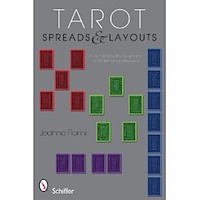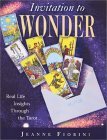By Jeanne Fiorini
Shifts on the calendar bring with them new opportunities, and I am happy to say that after many months of hard work and many more months of waiting for publication, my new book Tarot Spreads and Layouts: A User’s Manual for Beginning and Intermediate Readers (published by Schiffer Publishing Ltd. / www.schifferbooks.com) is now available from your local bookseller and online retailers.
I’m very proud of the content in this book. It is the compilation of 20 years of experience reading and teaching Tarot, and is a book which offers exactly what the title proclaims: practical guidance and simple yet effective tools and methods for reading Tarot cards. In the ideal world this book would be spiral-bound so that it could be placed open and flat on the table while the layouts are in use, but if you’ve ever had anything published you know that these sorts of things aren’t easily accommodated.
Regardless, it is my hope that this book, once purchased, becomes dog-eared, coffee-stained, annotated, and bookmarked to within an inch of its life. Tarot Spreads and Layouts was created to be an easy-to-use resource, practical in its guidance and advice, and thorough in the scope of queries that can be addressed by the methods described therein.
Some of you might be happy to hear that none of the 14 spreads, or any of the 18 different methods described in the manual, require more than 8 cards. This leads to our first tidbit from Tarot Spreads and Layouts:
“Here’s something important to remember about Tarot spreads and layouts: there is no big mystery, no magical or arcane formula that qualifies them as authentic. Of course, there are the established and venerated layouts such as the Celtic Cross or the Gypsy spread, but these are complex, web-like patterns consisting of numerous cards with intertwining connections, and as such aren’t always the best choice.
These particular layouts are not always the best choice, not because they are for “experts only,” but because they provide much more input than is required. All those images and all those card meanings and all that information can be overwhelming, and in truth, are unnecessary. The good news is that Tarot spreads don’t have to be complex in order to be effective. Let’s face it, the seventy-eight cards themselves are challenging enough without adding a complicated layout to the mix”. …. from the Introduction, page 7.
It doesn’t take long for someone who’s learning the Tarot to experience the sometimes-illogical twists along the path to the knowledge and understanding of the system. Here’s just one thing that makes learning to read Tarot cards challenging, this tidbit from pages 26-27:
“Any and all [of the 78 cards in the Tarot] need to be considered in context. All things are relative to all other things within any spread or layout, not to mention the fact that any one card can mean different things in different contexts”
Over time you may come to recognize or develop definitive (for you) associations/meanings for particular cards, but there is no big book up in the sky that holds an absolute and single meaning for any one card. Nothing in the Tarot is set in stone! Tarot readers have to learn how to be fearless with their trust in what they’ve learned intellectually and what they know intuitively, be it about any one card, set of cards, or about the overall message of a particular layout.
This personal relationship to the cards, this ongoing relevance to life with each new permutation and interpretation of the cards, is part of what makes the Tarot a dynamic system that continues to develop and expand into deepening layers of meaning. As new interpretations of the Tarot system go into the “pot of possibilities,” they also get stored in our collective unconscious as part of our intrinsic, inner knowing. “What one of us knows” becomes a small but relevant part of “what we all know.”
This concept of the Tarot’s connection to our collective knowing leads to last tidbit:
“When you work with your Tarot cards, you become a participant in the shaping and shifting of human consciousness.
Quantum science is beginning to prove something that we’ve known instinctively all along:
that we’re all connected, that we share a common energy field, that the ripple effect of our thoughts and actions is likely far greater than we could have dreamed. In this light, it is not an overstatement to say that the consciousness of the human family is impacted each time someone uses their Tarot deck in an effort to seek out that which is true and real.” ….. page 33.
It is true, then, that any piece of self-awareness, self-development, or increase in the level of one’s consciousness is a heroic act, working in positive ways for the betterment of oneself and the human community of which we are a part. But the pursuit of self-development isn’t a walk in the park; a recent client expressed the fact that her therapy has put her in a place where she’s nervous and uncertain about where her life is headed. Helpful Hint: If you don’t want things to change, don’t go into therapy….and don’t pick up your Tarot cards….
…..because once you start to prod your conscious and unconscious knowing with archetypes, symbols, and new layers of thought and meaning, things will change. When the time comes that you’re ready for a guidebook to help along the Tarot road, pick up Tarot Spreads and Layouts: A User’s Manual. It will prove to be a useful resource on the path to understanding the Tarot –and yourself.


